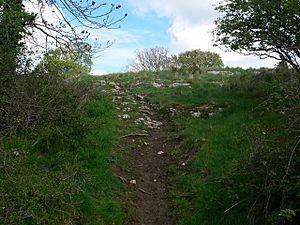Bedd-y-Cawr, St Asaph facts for kids
Quick facts for kids Bedd-y-Cawr Hillfort |
|
|---|---|

Path up Bedd-y-Cawr
|
|
| Type | hillfort |
| Location | Denbighshire, Wales |
| OS grid reference | SJ 0132 7205 |
| Official name: Bedd-y-Cawr Hillfort | |
| Reference no. | DE037 |
| Community | Cefnmeiriadog |
| Principal area | Denbighshire |
| Lua error in Module:Location_map at line 420: attempt to index field 'wikibase' (a nil value). | |
Bedd-y-Cawr Hillfort is an ancient hillfort from the Iron Age period. It sits on a natural high point of land in Cefnmeiriadog, Denbighshire, in North Wales. The name Bedd-y-Cawr comes from the Welsh words for "Giant's Tomb."
This important historical site is a scheduled monument, which means it's protected by law. You can find it about 3.3 kilometers (2 miles) west of St Asaph and 4 kilometers (2.5 miles) north of Henllan.
Contents
What is Bedd-y-Cawr Hillfort Like?
This hillfort is built on the end of the Cefn Meiriadog ridge, which is part of the Rhos Hills. From here, you can see amazing views over the River Elwy valley. This area has many hillforts, showing it was an important place long ago.
How Was the Hillfort Built?
Bedd-y-Cawr Hillfort is shaped like a rough rectangle. It measures about 156 meters (170 yards) long and 74 meters (81 yards) wide. The total area is about 0.8 hectares (2 acres). To protect the people inside, the hillfort had a ditch and a bank on its north-west and north-east sides. There was also a simple entrance. On the west and east sides, natural limestone rocks helped protect the fort.
When Was Bedd-y-Cawr Hillfort Discovered?
Experts from the Royal Commission on the Ancient and Historical Monuments in Wales and Monmouthshire first visited Bedd-y-Cawr in 1912. It was officially named a scheduled monument in 1927.
Why is it a Scheduled Monument?
Being a scheduled monument means the site is very important and needs to be preserved. In 1998, the protected area of the hillfort was made larger. This was done to make sure the entire defensive site, not just the inside, was safe. It is now known as a prehistoric defensive hillfort.

